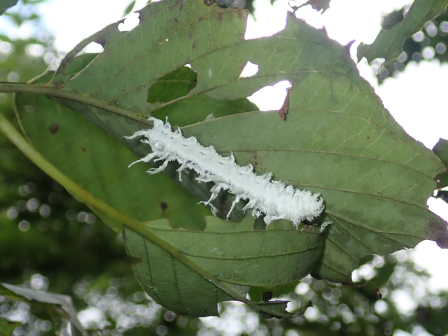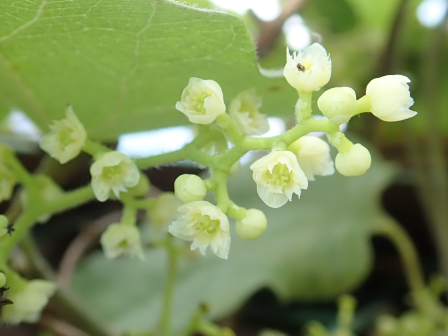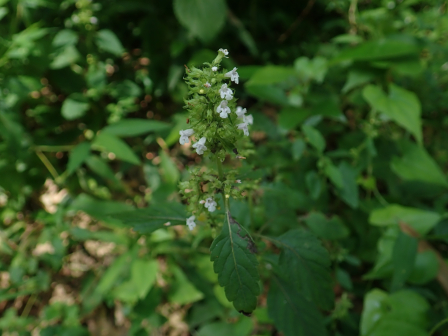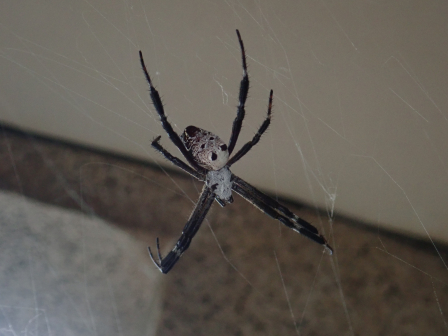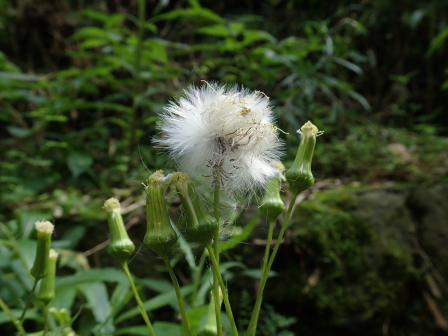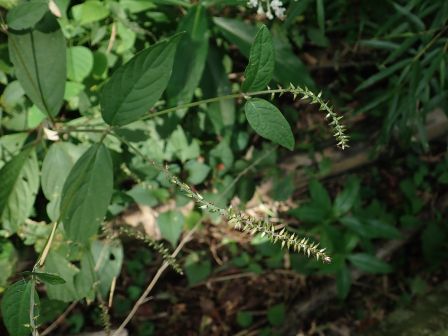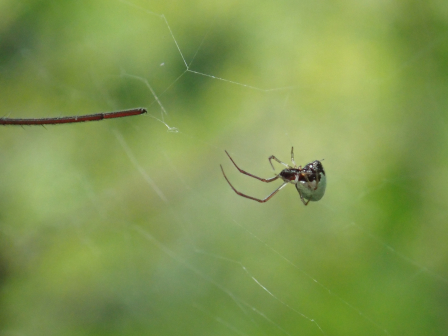フィールド日記
2022年09月
2022.09.30
アゲハモドキ
共生の森でアゲハモドキという蛾の幼虫を見つけました。白いロウ状の物質に覆われています。食草はミズキ類で、この個体はクマノミズキの木にいました。成虫はジャコウアゲハにそっくりな姿をしています。
I found a larva of a moth called "Ageha-Modoki (アゲハモドキ)" in the Kyoseinomori (共生の森). They eat leaves of trees belonging to "Mizuki (ミズキ)" group and this larva was on a leaf of a "Kumano-Mizuki (クマノミズキ)" tree. Their adults look like a butterfly called "Jakou-Ageha (ジャコウアゲハ)."
2022.09.27
アオツヅラフジ
グラウンドでアオツヅラフジが咲いていました。がくと花弁がそれぞれ6枚ずつありますが、どちらもクリーム色をしていて花弁のように見えます。秋から冬にかけて青紫色の果実をつけ、中にはアンモナイトのような種子が入っていることで有名です。(種子のようすはこちら)
"Ao-Tsuzurafuji (アオツヅラフジ)" plants are in bloom in the school ground. They have 6 calyces and 6 petals and they are all cream-colored and look like petals. They are well known for the fact that they bear bluish purple fruit from fall to winter that contain the seeds looking like an ammonite fossil. (click here to see the seed.)
2022.09.23
イヌトウバナ
裏道でイヌトウバナが咲いていました。やや湿った林縁などによく見られます。植物では、ある植物に似て非なる植物の名前にイヌと付けることがあります。本種もトウバナに似ているので、イヌトウバナと呼ばれていると思われます。
"Inu-Toubana (イヌトウバナ)" plants are in bloom on the back road. They are often seen on the edges of humid forests. Some plants have the names starting with "Inu (イヌ)" when they look like diffrent relative species. This species has a relative species called "Toubana (トウバナ)", so this one is called "Inu-Toubana (イヌトウバナ)".
2022.09.20
キツネノマゴ
キツネノマゴが咲いています。日当たりの良い道ばたなどに生える1年草です。和名は花穂がキツネの尻尾のように見えることと、大きさが小さいことに由来するそうです。
2022.09.16
マルバノホロシ
裏道でマルバノホロシが咲いていました。紫色で、ナス科特有の形をしています。花弁が大きく反り返ることが特徴です。秋から冬にかけて赤い実をつけます。
"Marubano-Horoshi (マルバノホロシ)" plants are in bloom on the back road. The flowers are purple and their shape is unique to the eggplant family. One of their characteristics is that the petals are recurved back. They bear red fruit from fall to winter.
2022.09.13
スズミグモ
渡り廊下にスズミグモがいました。和名は巣に住むクモという意味だそうです。もともと温暖な地域に住むクモですが、分布を北に広げています。
I found a spider called "Suzumi-Gumo (スズミグモ)". The name means spiders living in a nest. They originally live in southern area of Japan but now they are spreading toward the north.
2022.09.09
ダンドボロギク
裏道でダンドボロギクが見られます。北アメリカ原産の帰化植物ですが、和名は日本では愛知県の段土山(だんどさん)で見つかったことに由来します。花は筒状花のみからなり、あまり目立ちませんが、花後の綿毛がよく目立ちます。
You can find "Dando-Borogiku (ダンドボロギク)" plants on the back road. They originally came from North America, but they were named after the "Dando" mountain in Aichi prefecture where they were first found in Japan. The flowers consist of only tubular flowers so they do not stand out very much but the fluffs are quite visible after the flowers have bloomed.
2022.09.06
ヒカゲイノコヅチ
裏道でヒカゲイノコヅチが咲いていました。名前の通り、日陰になる林内でよく見られます。
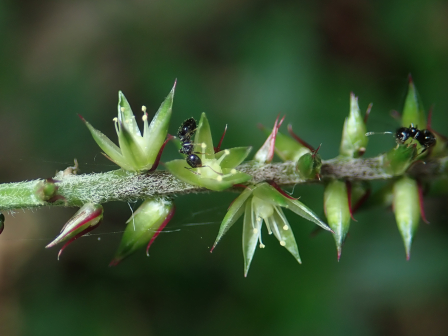
2022.09.02
シロカネイソウロウグモ
前回紹介したジョロウグモの写真の右上に、小さいクモが見られます。シロカネイソウロウグモです。名前の通り、他のクモの網に居候して、獲物を盗み食いして生きています。本種は特にジョロウグモの巣を好むようです。
You can see a small spider on the upper right in the photo posted last time. This spider is called "Shirokane-Isourou-Gumo (シロカネイソウロウグモ)". The name suggests that this spider lives on another spider's web and steals prey to eat. This species prefers especially "Jorou-Gumo" spiders' web.
- 1 / 1


